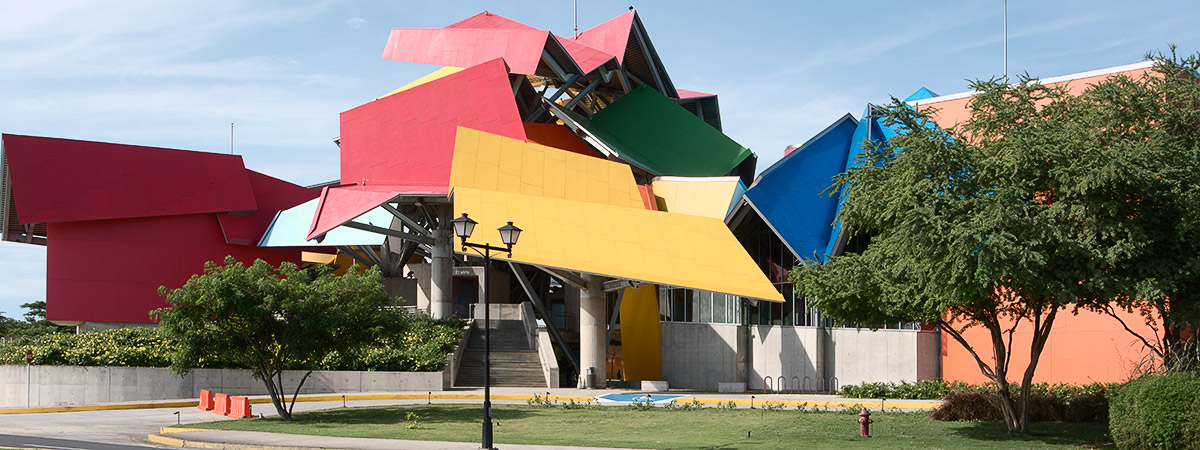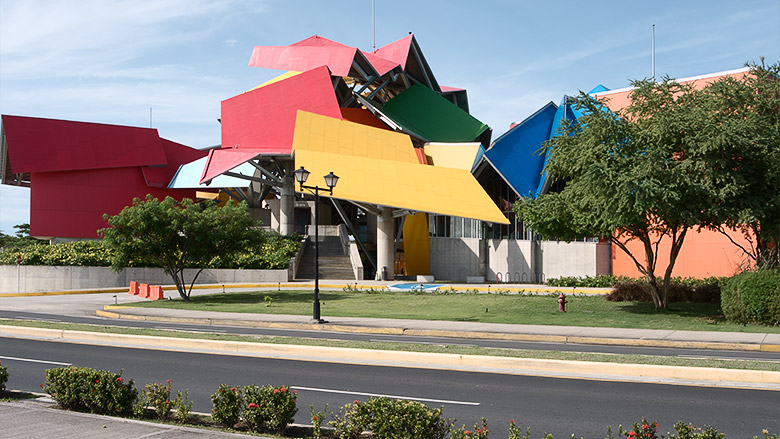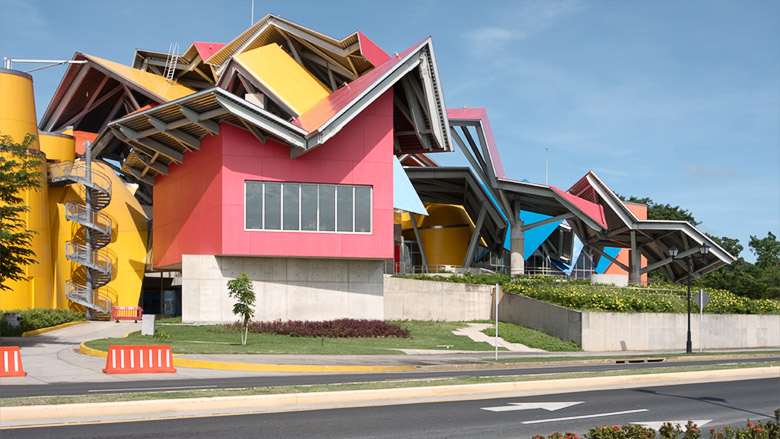


biodiversity museum amador causeway panama city
Situated along Panama City's famous Amador Causeway, the Biodiversity Museum is a visually stunning structure designed by world-renowned architect Mr. Frank Gehry. Construction began in late 2004, and the museum opened on October 2, 2014, at a cost above 60 million dollars.
The Biodiversity Museum is excellent. It is clean, spacious, and open, courtesy of the high ceilings. There are eight permanent exhibition galleries — each with a unique focus, delivered thoughtfully and with much attention to detail in the material examined. The staff was attentive, friendly, and genuinely interested in my experience. So, if you want to delve into Panama's rich geological and biological history, the Biodiversity Museum would be a great place to do it.

Biodiversity Museum – a view of the beautiful museum from the main road, looking west-southwest. Like most of Mr. Gehry's projects, it is bereft of symmetry, so every angle presents a different look and feel.
The entrance to the museum leads you up a flight of stairs into a large open atrium. The ticket window is to the left, and the museum entrance is across from it, to the right.
Upon entering, the glass wall on the right, adorned with semi-transparent wildlife illustrations, offers a view of Panama Bay. Along the left wall are wooden carvings, wildlife images, and displays housed in glass cabinets. There are nine separate digital screens. Sometimes, each screen displays unique content, and others when multiple screens share a single image. In addition, there are two balconies, each providing views of the museum's main content area below. Hanging above and along the steel structure are replications of scarlet macaws, Harpy eagles, and other flora and fauna. Further back is an array of small, rectangular plaques, each with a single-line illustration depicting a particular animal species and descriptive text. Overall, it is a pleasant beginning.
***
You'll then proceed into a dimly lit theater to watch a six-minute video titled "Panamarama," which consists of ten gigantic high-definition screens, each measuring a minimum of 20' in width and 30' in height. Two panels reside on the ceiling, front wall, side walls, and under the glass floor. You can stand or sit during the presentation. I saw both. The video serves as an introduction to Panama's rich biodiversity, highlighting its land and sea attractions. Like the digital screens along the entrance wall, each screen displays unique content, and at other times, the same image(s) are shared across the entire viewing platform, giving it a somewhat 3-D effect. All in all, it is an enjoyable presentation. The six minutes pass quickly.
***
After departing the theater, you enter Panama's past. Beginning 70 million years ago, long before Panama formed, the museum takes you through the process of Panama's volcanic formation. On display is an abundance of geological artifacts from that era, e.g., rocks, sediment(s), etc., each with descriptive text in English and Spanish. There are several bilingual, interactive digital screens with insightful information. Many display arrows along both sides to shift/swipe content from one information panel to another; most presentations consist of four content panels. There are also on-screen buttons you can touch to bring up additional content; there's a wealth of information hidden off-screen.
***
You then move into a large, open atrium with immense animal replications. Before the isthmus of Panama formed, animals were limited to North or South America. For the first time, the isthmus allowed them to migrate between both hemispheres, and this portion of the museum highlights the vast array of animals that once existed and have endured. The walls are covered — floor to ceiling — with beautiful monochromatic illustrations of endemic flora and fauna. Several floor-mounted interactive screens allow you to search between extinct and existing animal species based on their diets and other criteria. There's a lot of exciting information to be accessed.
***
Later, you exit into a ground floor outdoor patio; it's open and airy, though covered by the atrium above. You'll find sixteen large, square cement pilings; each of the four sides displays photographs, illustrations, and text. The displays are grouped by color — green, orange, blue, and peach — each with a unique focus. There is a lot to read! You could easily spend 30-45 minutes getting through it all. Though not nearly as visually appealing as the other exhibitions, it contains plenty of relevant information.
***
On the far side is the entrance to the museum's marine exhibit. Inside, you'll find two two-story-tall aquariums. The tank on the left has Atlantic marine life, and the other has a collection of Pacific species. Near each are small plaques displaying the different fish species. In addition, there are smaller displays of mangroves and corals. Like in the other exhibits, you'll find interactive digital screens with additional information relating to Panama's particular marine life.
***
You'll then step up to a mezzanine that is an open, spacious, well-lit room, care of the floor-to-ceiling glass windows. Here, you'll find flora and fauna replications on the ceiling and walls and several interactive screens; this exhibit employs one-piece headphones for narration. I didn't see these used anywhere else.
***
The last remaining exhibit takes you back to the second floor, where you'll get another, higher view of the fish tanks. In addition, several presentations, accompanied by bilingual text and interactive screens, are present.

Biodiversity Museum – looking back at the museum from the other side, further south along the causeway.
In many respects, the Biodiversity Museum simulates a natural or national history museum. It focuses primarily on the past, with little mention of modern-day Panama or its future. But, this appears to be their intent.
Of the museum, their website states:
"It was designed to tell the story of how the Isthmus of Panama rose from the bottom of the ocean and united two continents, divided an ocean, and changed the world's biodiversity."
And the museum does just that, exceptionally well. It closely examines the isthmuses' initial inhabitants and the vast array of animal life that previously existed.
To photograph the museum's exterior, you will need a wide-angle lens. Unfortunately, there isn't much room out front along the road. I took the above pictures with a 25mm on a cropped sensor DSLR, and, as you can see, I clipped both sides of the building; a 15-20mm would be better. The trees and shrubs have grown considerably since then, but you can still find enough open space to capture pleasing images.
If you walk south along the Causeway towards Flamenco Island and look back, a 70-200mm telephoto lens will work fine.
Camera support isn't necessary. There is cement everywhere.
Note: Pictures taken inside the museum are permitted without flash, though I saw people snapping pictures with their cell phones using its built-in flash. No one seemed to care, so if you don't draw too much attention to yourself, you shouldn't have any problems. The large, floor-to-ceiling glass windows allow plenty of light to enter for picture-taking. Unfortunately, the theater and marine exhibit are dimly lit areas, but there is nothing to photograph.